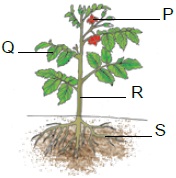Subject :NSO Class : Class 8
Subject :NSO Class : Class 4
Match the given columns and select the correct option.
| Column I | Column II | ||
| (A) | Green plants | 1. | Dead plant and animal remains |
| (B) | Earthworm | 2. | Blood |
| (C) | Mosquito | 3. | Nectar |
| (D) | Butterfly | 4. | Sunlight |
A(A) - 1, (B) - 2, (C) - 3, (D) - 4
B(A) - 4, (B) - 1, (C) - 2, (D) - 3
C(A) - 4, (B) - 2, (C) - 1, (D) - 3
D(A) - 3, (B) - 2, (C) - 1, (D) - 4
yep
Post Your Answer
Subject :NSO Class : Class 4
Post Your Answer
Subject :NSO Class : Class 8
Post Your Answer
Subject :NSO Class : Class 2
Post Your Answer
Subject :NSO Class : Class 4
Post Your Answer
Subject :NSO Class : Class 4
Post Your Answer
Subject :NSO Class : Class 3
Post Your Answer
Subject :NSO Class : Class 3














